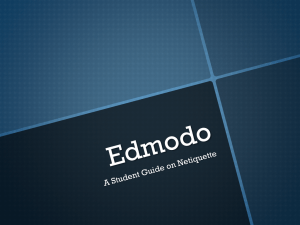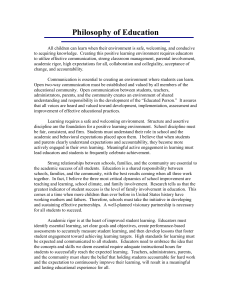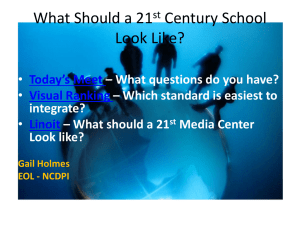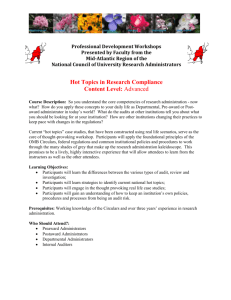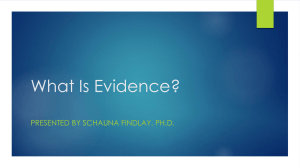RTT-D aligned language to support personalized learning
advertisement
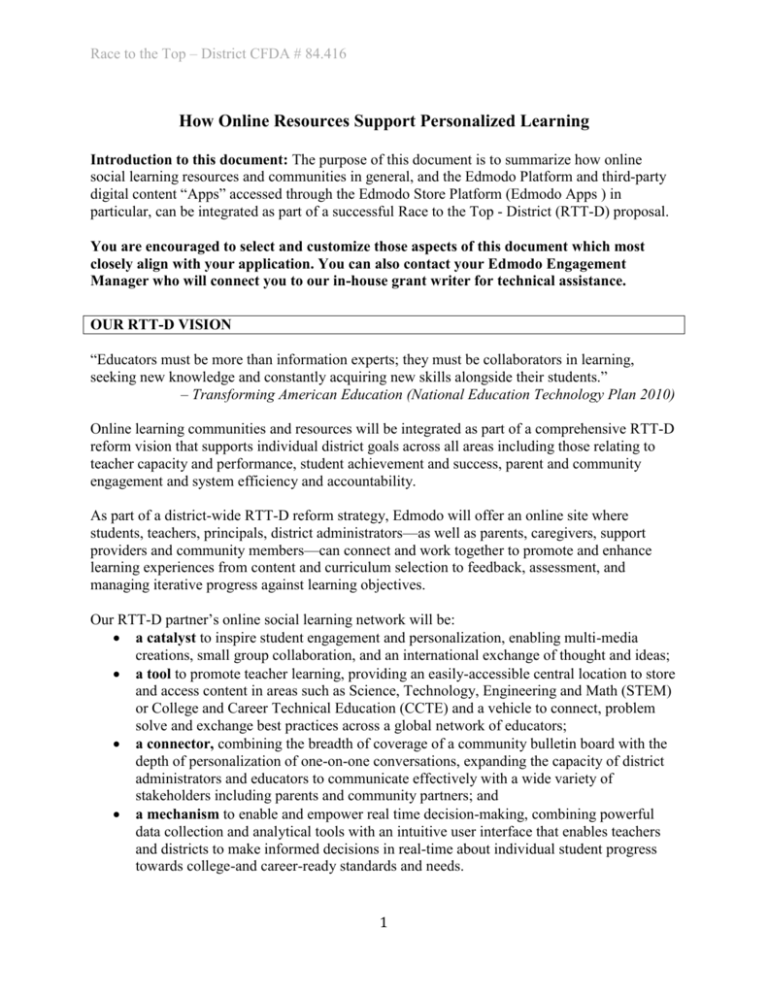
Race to the Top – District CFDA # 84.416 How Online Resources Support Personalized Learning Introduction to this document: The purpose of this document is to summarize how online social learning resources and communities in general, and the Edmodo Platform and third-party digital content “Apps” accessed through the Edmodo Store Platform (Edmodo Apps ) in particular, can be integrated as part of a successful Race to the Top - District (RTT-D) proposal. You are encouraged to select and customize those aspects of this document which most closely align with your application. You can also contact your Edmodo Engagement Manager who will connect you to our in-house grant writer for technical assistance. OUR RTT-D VISION “Educators must be more than information experts; they must be collaborators in learning, seeking new knowledge and constantly acquiring new skills alongside their students.” – Transforming American Education (National Education Technology Plan 2010) Online learning communities and resources will be integrated as part of a comprehensive RTT-D reform vision that supports individual district goals across all areas including those relating to teacher capacity and performance, student achievement and success, parent and community engagement and system efficiency and accountability. As part of a district-wide RTT-D reform strategy, Edmodo will offer an online site where students, teachers, principals, district administrators—as well as parents, caregivers, support providers and community members—can connect and work together to promote and enhance learning experiences from content and curriculum selection to feedback, assessment, and managing iterative progress against learning objectives. Our RTT-D partner’s online social learning network will be: a catalyst to inspire student engagement and personalization, enabling multi-media creations, small group collaboration, and an international exchange of thought and ideas; a tool to promote teacher learning, providing an easily-accessible central location to store and access content in areas such as Science, Technology, Engineering and Math (STEM) or College and Career Technical Education (CCTE) and a vehicle to connect, problem solve and exchange best practices across a global network of educators; a connector, combining the breadth of coverage of a community bulletin board with the depth of personalization of one-on-one conversations, expanding the capacity of district administrators and educators to communicate effectively with a wide variety of stakeholders including parents and community partners; and a mechanism to enable and empower real time decision-making, combining powerful data collection and analytical tools with an intuitive user interface that enables teachers and districts to make informed decisions in real-time about individual student progress towards college-and career-ready standards and needs. 1 Race to the Top – District CFDA # 84.416 Value Proposition: Online learning communities and resources in general offer multiple benefits to school districts seeking to maximize their RTT-D resources: Usability – evolved online learning platforms, such as Edmodo, have been developed to address barriers such as historic teacher reluctance to adopt and fully utilize new technologies. They also offer access to multiple high quality curriculum applications (apps) developed by industry recognized third party providers that provide instructional content aligned to standards (common core, college and career readiness). Edmodo offers one platform that is intuitive for newcomers to use, with the capacity to meet both teacher professional development and student learning needs. Flexibility – online learning platforms, arguably more than any other approach to learning, offer capacity for teachers to establish and efficiently manage personalized learning environments for themselves as well as for individuals and groups of students; Actionable Analytics – online learning platforms where all learning activities are conducted position districts to understand the full range of influences, inputs, and milestones that contribute to student learning and track the efficacy of spending from professional development for teachers to student learning outcomes. Scalability – online learning platforms makes it easy to scale efforts across the district. Through closed private groups, teachers and administrators can easily push and share information, content, and best practices “just in time,” without needing to take practitioners out of the classroom. Technology is the ultimate tool for scaling initiatives. In the past, when district administrators wanted to scale innovations happening in one school across many, they faced skyrocketing costs to replicate and share materials, limited ability to provide supports, difficulties with quality control and little to no insight into depth of implementation. With an online social learning platform, district administrators can build off of what’s already happening in classrooms, expanding organically. Trying to promote a new practice from central office starting from scratch can literally require multiple years and tremendous resources devoted to marketing before full adoption; even then, it is difficult to gauge fidelity let alone effectiveness. One of the benefits of going to scale with a social learning platform is that many teachers—more and more each day—are already using it. With the platform already in use in many classrooms and schools, district administrators can build off the energy already bubbling up from teachers and devote their energies to leveraging and supporting innovations at scale. Additionally, using a social learning platform gives school and district administrators visibility into fidelity and effectiveness quickly. Sustainability – Purchasing district-wide hard-copy materials such as textbooks or devoting resources to in-person training can be cost-prohibitive. In contrast the Edmodo platform is available at no cost. However, districts aiming to realize the full value of the platform can allocate resources to support the purchase of online content that support their instructional and professional development priorities at a fraction of the cost. In fact, all content currently used in districts can be centralized and used through Edmodo, aggregating data tracking and analysis with a lightweight deployment. Training on how to use Edmodo is provided at no cost through a one-hour webinar or through a more intensive “train the trainer” model. 2 Race to the Top – District CFDA # 84.416 LEARNING The following are ways in which online learning communities and resources can prepare your students for college and careers. Specific examples of ways that students can benefit from an online social learning platform that can be matched with your RTT-D specific goals and outcomes are also provided. Goal: Personalize Student Learning In the field of education, there is growing appreciation of the importance of personalizing students’ learning experiences. When students are deeply connected to content and are able to apply learning, they stay motivated. They need personalized learning environments and experiences that move them away from the traditional passive role of listening in a classroom to a teacher at the front, toward taking the driver’s seat, actively navigating their learning process. Students can benefit from an online social learning platform as they: Discover and clearly communicate their own learning style and preferences; Choose from a variety of multimedia formats and modalities to explore academic topics; Gain access to their teachers at any time to ask questions and seek guidance outside of class; Create multi-media projects and presentations, customizing and enjoying their work; Express and explore their personal viewpoints in moderated debates, poetry walls, or in a threaded communication stream; and Explore academic topics that might be outside the scope of their school’s curriculum or their teacher’s individual knowledge base. Goal: Increase Student Engagement Young people are growing up in an increasingly wired world. They instinctively use technology to connect with each other and the world around them, to explore areas of interest, and to express and enjoy themselves. Smart educators see this as a strength and use technology to tap into students’ creativity, energy and enthusiasm for learning. Online, students can have a high degree of independence while teachers are still able to monitor progress and offer guidance. Students can benefit from an online social learning platform as they: Experience learning as fun and relevant; See the direct connections between standards-based academic material and the real world through the power of the Internet; Are empowered to create multi-media explorations of different topics; Connect with teachers and classmates in a way that feels comfortable; Demonstrate content mastery in multiple ways or dimensions; and Transcend the four walls of the classroom, using smartphone apps and/or a mobile classroom site that enables an anytime, anywhere mobile learning environment. Goal: Support Development of 21st Century Skills To succeed in today’s world, students need more than academic knowledge. They need learning and innovation skills such as critical thinking, communication, problem-solving and creativity. They need life and career skills such as leadership, self-direction and the ability to navigate 3 Race to the Top – District CFDA # 84.416 different cultures. When students use an online social learning platform to investigate, question and research, they become better prepared for a global, knowledge-based economy. Particularly for the STEM fields, where technology is at the core of the practice and new innovations continue to morph and exponentially grow the fields, students will need to be tech-savvy to thrive. Using technology in direct service of standards-based learning gives students the confidence and lifelong skills that will enable them to investigate, understand and enjoy the world around them. School is just in session six hours a day. With a single learning platform that can be accessed from any device, the discussions and learning experiences that may begin in the classroom can blossom and deepen outside of the school day. High school students who do not have access to specific advanced placement (AP) courses at their school, or who can not take advantage of such courses due to schedule conflicts, can access online courses and connect with teachers as part of virtual classrooms. Students can benefit from an online social learning platform as they: Collectively problem-solve and work through challenges with peers in collaboration groups; Connect with students all across the globe; Engage in project-based learning; Become adept at using technology, understanding how to access and utilize the Internet specifically in the service of learning; Discuss and exchange ideas and content in a secure, closed environment; and Charter their own learning experience, moving away from the traditional passive role of listening in a classroom to a teacher at the front, toward taking the driver’s seat, actively navigating their learning process. Goal: Support High-Need Students Students with greater needs and who are at risk for academic failure require greater supports. For example, overage and under-credited students can become increasingly checked-out. Transitioning students, from middle to high school, can lose their support system and encounter challenges. Students who are in foster care, who have been incarcerated, who have disabilities, or who are limited English proficient all require more personalized instruction. Unfortunately, the typical structure of school systems is not always able to provide the range of supports these students need. In fact, some of the highest-need student populations are taught by the least qualified teachers. And students quietly falling behind can simply go unnoticed. With multiple mechanisms and tools online to measure and monitor learning, if a student begins to get off track or just isn’t making sufficient progress, connected educators instantly know. It isn’t up to the atrisk child to raise the distress flag; adults can immediately respond and intervene. High school students who are course or credit deficient and who are at risk of not meeting requirements for graduation or college entrance due to issues such as high mobility (including students from military families, foster students and homeless students), poor attendance or learning challenges can be connected to online courses, developed by established publishers, which meet graduation and college entrance requirements. With online assessments mapped with leveled content, overage students can take advantage of the wide array of online resources and engage with ageappropriate content and materials that match their particular learning styles and needs. Digital resources make it easier for students from all backgrounds, ethnic groups, income levels, and geographies to access learning experiences beyond what is immediately available to them at their 4 Race to the Top – District CFDA # 84.416 school. Additionally, English Language Learners can access Edmodo in either English or their native language. The platform is localized in several languages, including Spanish, with more localizations added regularly. High-need students can benefit from an online social learning platform as they: Learn more with just-right content; Connect with other students as they transition, for example from middle to high school, or change schools; Get more help when they need it; Thrive with better prepared teachers; Have access to highly effective teachers; and Have access to content that meets their specific linguistic needs. Examples of ways that students can benefit from an online social learning platform that can be matched with your specific goals and outcomes include: Students can take an online learning style quiz to ascertain how they best engage with new information. The data can be stored as part of a student’s personal profile or portfolio, ensuring that future teachers also have access to the same insights into learning styles/preferences. Teachers can use this information about students’ learning styles to tailor classroom strategies curate curriculum-aligned content experiences unique to each student. Students who are credit-deficient can complete required coursework online and outside of traditional school hours if needed, within a smaller personalized learning group facilitated by an expert teacher. Students can approach the same material in different ways, ranging from working by him/herself with interactive web-based content, to collaborating with a group on a project, to competing in a multiplayer game with other students. If a student didn’t have time to ask a question in class, if a question didn’t arise until engaging with homework, or if a student is simply too shy to ask a question, a secure online classroom forum extends their learning opportunity beyond the four walls of the classroom and the hours in the school day. Students can work at their own pace on projects of their choosing in multimedia formats, such as creating a comic demonstrating mastery of mitosis or a video showing a real world application of gravity. Students can choose to interact with new knowledge in a wide variety of modalities and formats, engaging different parts of their brain and selecting what approach resonates most with them or deliberately stretching themselves. Students can play standards-based web games, or interact with topic-based videos, responding to teacher cues throughout to post hypotheses or gain feedback, staying engaged as they make progress. 5 Race to the Top – District CFDA # 84.416 Students can be connected to diverse real world experiences and individuals that bring their learning into context such as breaking news stories or students from another county. Students can be connected to organizations or professionals working in related fields who can help them understand multiple career pathways. Students can learn valuable 21st century skills by creating a PowerPoint presentation that incorporates videos, photos and sound to explain that same topic to peers is likely to get them invested. Students can work together with peers and advisors to share documents, video, pictures, interviews, research, data, etc., and in the process learn about how to function productively in a team. Students can access online mentoring or buddy systems as well as class-based communities can help transitioning students adjust well to their new environments. TEACHING and LEADING The following are ways in which online learning communities and resources can support the professional goals and capacity building needs of teachers and other district staff and meet the RTT-D requirement to ensure that “all participating educators engage in training, and in professional teams or communities, that supports their individual and collective capacity to support implementation of personalized learning environments, adapt content and instruction and optimize learning approaches, measure student progress and develop instructional practices”. Specific examples of ways that teachers and leaders can benefit from an online social learning platform that can be matched with your RTT-D specific goals and outcomes are also provided. Goal: Improve and Expand Professional Learning and Growth The demands facing today’s teachers are greater than ever before, and in an increasingly competitive and complex world those demands will only increase. Classroom teachers and principals desperately need a relevant, personalized and constant infusion of wisdom, advice and expertise to help them keep up and continually improve their practice. A social learning platform can help districts offer a scalable and effective, yet engaging and highly personalized professional development experience for every teacher. Specifically, district administrators can use an online social learning platform to: Expand the reach of professional development by offering content online; Track professional development impact beyond delivery through to teachers’ classroom practice; Help teachers answer specific questions through on-demand personalized training; Create affinity or mentorship groups, for example for new teachers, teacher leaders, ELL teachers, 3rd grade teachers, or new principals to connect educators with similar concerns; Gather valuable feedback on teacher needs and how to improve upon professional development efforts; 6 Race to the Top – District CFDA # 84.416 Make in-person professional development more interactive and engaging; Better support new teachers; Cultivate teacher leadership by giving motivated, interested teachers the opportunity to lead discussions, teach others their innovations, or share successes; Access personal learning networks that can both drill down into the specific, practical, daily needs of educators and blossom into career-spanning communities of practice, fostering and sustaining lifelong learning; and Ensure STEM teachers are keeping current with their rapidly-changing and developing fields. Goal: Increase Teacher Capacity Teaching, despite of all the interactions with students, can be a lonely professional endeavor. It can be difficult for teachers to find the time to collaborate with other teachers or other district staff such as guidance counselors. It can also be challenging for school or district administrators to find the time to take teachers out of the classroom for a face-to-face professional development experience. Even with time, there’s no guarantee that the teachers physically nearby will have the knowledge, expertise and skill set to answer specific questions, provide guidance or offer new ideas. An online social learning platform gives every teacher the benefit of tapping into the best advice and trending content including hundreds of third-party, standards-aligned content applications. Online learning communities and resources are providing teachers with a means to access training that best meets their individual professional development needs and goals. Growing numbers of teachers are currently engaged online supported professional networks and learning communities. RTT-D will provide an opportunity to take this activity to scale as part of a focused district wide reform effort. Teachers benefit from an online professional learning communities as they: Access teaching expertise within a global network of educators; Access a wide variety of high-quality, standards-aligned instructional content and learning resources that have worked in other classrooms and which are fully integrated within the Edmodo platform; Delve deeper into subjects of interest in an online professional learning community where teachers from all over the world can convene—virtually—over shared interests to discover and share best practices; Ensure they are continually learning and keeping abreast of new information, new modalities and ways to approach, interact with and digest knowledge; Connect with other educators and reduce the sense of teacher isolation; Work in online, closed private groups with other teachers in their school or district to translate face-to-face district professional development into practice; and Embed and infuse professional learning into daily practice, making questioning, trying out new practices, and seeking out new resources easy and practical. Goal: Easy, Convenient Instructional Management The effectiveness of a teacher isn’t just about how he/she connects students and material in the classroom. A lot of what makes a good teacher happens outside of class time, e.g. communicating effectively with students and parents as well as with colleagues from other district departments (i.e. counseling and guidance) and community partners; organizing materials 7 Race to the Top – District CFDA # 84.416 and content and sharing it well with students; keeping track of and reminding students and parents of upcoming class and school events; effectively managing parent volunteers and classroom aides; and maintaining the safety and security of students. An easily-searchable site can help teachers meet the challenge of creating and managing relevant and engaging standardsbased learning experiences for students each day. Custom-designed for the classroom, Edmodo was designed to promote student safety and enable digital citizenship. Utilizing closed private networks or groups, students are always linked with their teachers and are not discoverable by those users outside their groups. Additionally, communication flows mirror the best of the classroom, with teachers always having visibility into student-to-student communications. Teachers can use an online social learning platform to help meet these communication and organizational needs by: Creating classroom portals—viewable via smartphone—ensuring that families, classroom volunteers, and teacher aides have all-in-one easy access to their students’ classwork, school events and reminders about classroom activities; Storing, managing and sharing content in a cloud-based environment; Providing students with a virtual backpack, making it easier for them to stay organized and connected; Enjoying easy, convenient, smartphone-accessible communication with students; Communicating with parents and families about updated calendars, reminders, and electronic versions of all of the paper communication from school, from field trip permission slips to classroom supply lists to bus schedules; and Providing parents with specifics about classroom curriculum, school policies or updates regarding their child’s progress – effectively linking and enhancing the connection between school and home. Goal: Provide Support for Differentiating Instruction A one-size-fits-all education ends up working for almost no one. The only way to reach every student and maximize their learning potential is to differentiate instruction. The rhetoric/reality gap with this concept is, unfortunately, huge because actually differentiating instruction in the classroom can be extremely challenging. One teacher with 30 students whose skill levels span several grades across multiple subjects is simply not able to keep up. That’s where an online social learning platform can offer much needed help. By managing their students’ learning and content interactions on a single platform, teachers gain insight into valuable student engagement and progress metrics that help them make decisions about how to allocate their time and/or resources (e.g., “time on task,” how many students watched the videos, which students rewatched which part of the video etc.). The difficulties of seamlessly integrating supports for students, particularly those with special needs, can be much alleviated by managing Individualized Education Programs (IEP) development and progress through a single online, closed private group to coordinate intervention. Technology can connect each and every student, giving teachers the tools they need to manage each students’ learning trajectory such that all students can meet rising college and career expectations. All information gathered on and created by a student then follows that student across subjects and along grades, helping future teachers similarly gain a deep understanding of individual students’ context and needs. Teachers can benefit from an online social learning network as they: 8 Race to the Top – District CFDA # 84.416 Identify students’ academic strengths, areas requiring more support, as well as learning styles and preferences through online quizzes and diagnostics; Use data and analytics to get the information they need to ensure their instruction is tailored according to each student’s individual learning plan; Closely monitor a large volume of students’ mastery of content through frequently updated student data and progress tracking; In a closed, secure site teachers can have one-on-one interactions with students to offer academic acceleration and remediation, as well as to gain insight into what works best for individual students; Use technology to create more differentiated, personalized learning opportunities in the classroom; and Encourage student independence and self-directed learning through outside-of-class projects, while also being able to guide and enhance learning at different levels. Goal: Help with At-Risk Students Perhaps one of the most pressing challenges facing educators today is the vast number of students considered at-risk, falling behind academically and failing to acquire the knowledge and skills that will enable them lead productive, successful lives. The difficulties facing some teachers working with intensely high-need populations are extremely daunting. Teachers can rely on an online social learning platform to: Coordinate and communicate personalized learning supports—or IEPs for students in Special Education—with a variety of teachers, service providers and caregivers; Connect to an online global network of educators giving teachers a virtually inexhaustible supply of materials, apps, lesson plans and ideas to work effectively with even the most challenging students; Keep close tabs on the learning and growth of at-risk students through integrated progress dashboards, online polls, one-on-one conversations, and quizzes, to ensure that they are continually mastering new content; Gain specific, granular feedback on ‘what’s working’ in helping at-risk students make the kind of accelerated gains they need to get to grade-level; and Utilize visual and auditory features offered online to work with special education and English language learners. Goal: Increase Access to Highly Effective Educators Top-down professional development fails to take advantage of all of the wisdom generated each day in the classroom by students and teachers. A social learning platform makes sure that knowledge percolates up, and district administrators can play a role in making sure the best ideas get shared, promoted and replicated and that teachers receive the supports they need rather than one size fits all professional development and communication. And with social learning platforms, the value of the product—or knowledge generated—grows with each additional user as each participant shares materials, wisdom and content so all educators in the district can develop world-class skills and knowledge. A social learning platform can facilitate mentoring, connecting the most successful classroom teachers with all new teachers entering the district. 9 Race to the Top – District CFDA # 84.416 Through video linked to prompts, threaded conversations in the stream, and a secure forum through which to ask questions, every beginning—and every struggling—teacher can have the opportunity to observe a well-organized, high-performing and engaged classroom in action. They can engage in dialogue about it, asking specific questions about how to replicate and apply best practices in their own classroom, and they can do it all from the comfort and convenience of their own home or while they are on the go through their smartphone. Examples of ways that teachers can benefit from a online professional learning communities and content that can be matched with your specific goals and outcomes include: Teachers can share and discover proven learning approaches, discuss ideas and get advice. If teachers have a breakthrough moment in class, they can share it so others can experience the same; if struggling, they can ask for help. Teachers can access expertise and extend their own learning, solving problems more systematically and efficiently with collective wisdom. Teachers have access to suggestion algorithms refined at scale to quickly understand which types of content or lessons will address the needs of their students and easily move from discovery mode to storage mode to delivery mode to deploy a customized learning experience for each student. Teachers can connect directly with teachers teaching the same topics or material as themselves to get “just in time” feedback and ideas or forge a deeper connection for the future. Teachers can start or join subject-specific groups that will extend professional development and promote lifelong learning. Teachers can create personal profiles where they state goals and interests, and share career achievements and successes in order to better focus interactions and connect with similarlysituated educators. New teachers can be connected to and supported by a network of veteran teachers who can provide online mentoring and coaching, either formally or informally. Teachers can continue to engage with other professionals as a follow-up to face to face experiences, i.e. after a Statewide conference or district level training. School and district administrators can use these groups as a way to build teacher capacity around specific strategic priorities or new practices. Teachers can create and manage a personal content library to store the best content they’ve discovered, shared, and received Teachers can quickly and easily search vetted, standards-based content, including third-party curriculum apps, to continually update and improve upon materials. 10 Race to the Top – District CFDA # 84.416 Teachers can give and manage assignments, including sharing all relevant content for a unit of study through ‘library’ folder sharing Teachers across multiple classrooms can all use results from quizzes and diagnostics to coordinate and target instruction via an algorithmic content suggestion engine. Results are automatically stored online and become part of individual students’ profile. Teachers have access to a continual feedback loop through an online dashboard and gradebook synced seamlessly with assessment inputs. Teachers can then make informed decisions about how to best facilitate each students’ learning trajectory. Teachers can get information about both the time a student devotes to tasks and how that time correlates to learning outcomes. For example, a teacher can gauge how a student is spending his/her time learning across activities from viewing a video to responding to a post in the stream to playing a math game. These inputs can then be correlated against outcomes to give teachers insight into what works best for particular students. Teachers can create online classroom ‘stations’, where students working in small groups can access different leveled content, including step-by-step instructions or how-to videos. Teachers can then create sub-groups within the online classroom group, enabling them to regularly check students’ progress. While still offering students a measure of academic freedom, teachers are better able to monitor and guide the direction of small group projects and adjust the pace of work if necessary. Teachers can connect with another teacher on the other side of the country or the world who’s trying to support a similar kid in a similar situation, giving each other much-needed support. Teachers can easily view the amount of time students are devoting to particular online activities When some yield higher learning benefits than others, teachers can use this helpful feedback to foster, encourage and provide more access to the type of content or third-party curriculum apps that work best. Teachers can utilize visual and auditory features offered online to work with special education and English language learners. 11 Race to the Top – District CFDA # 84.416 CONTINUOUS IMPROVEMENT Administrators need continual feedback on a variety of initiatives, touching a wide span of data points. Technology enables continual analysis on a variety of measures, from student achievement and attendance to parent and community engagement . Storing, analyzing and communicating all data in and from one place provides much-needed simplicity in a complex endeavor. The following are ways in which online learning communities and resources can support continuous improvement processes within districts: Goal: Provide Timely and Regular Feedback A high-functioning district is a transparent district, communicating all events, announcements, and new initiatives early and often to all constituents. Online social learning platforms such as Edmodo can assist such districts in their efforts to monitor, measure, and publicly share information on the quality and results of reform and improvement strategies by providing the ability to: Store all data all-in-one place. Comprehensive data storage and analytics enables continuous improvement across a wide spectrum of variables. When all data, from classroom quizzes to annual standardized assessments to disciplinary actions is warehoused together it enables teachers, principals and administrators to perform analytics, including: inquiring about the relation of program inputs to various outputs, comparing performance across schools, and gaining regular feedback on progress toward goals; and Provide just-in-time feedback to teachers, principals and administrators so as to support continual learning and quality improvement processes. Goal: Engage and Communicate with Internal and External Stakeholders A high-functioning school district maintains timely, strong, positive communications with everyone from principals to teachers to community business leaders to local nonprofit partners. Parent engagement is a major influence on student success yet connecting with parents in a meaningful and useful manner continues to be a challenge for many districts and schools, especially those working with high-risk student populations. Many parents don’t always come to back-to-school night or parent-teacher conferences. The reasons for this are numerous:many parents especially within socio-economic disadvantaged communities are working two or more jobs, they may not have reliable means of transportation or childcare, or there may be cultural or linguistic barriers that prevent them from fully engaging in their child’s education. As any parent will validate, the note in the backpack method of communicating is hit and miss at best with too many opportunities for critical information to be lost or received late. A social learning platform provides a secure, private community for stakeholders—including parents, teachers and principals—to communicate. This gives district administrators an extremely useful tool to navigate the complexities within and challenges across stakeholder groups. In private online groups district administrators can engage in specific Q&A sessions, or listen and respond to suggestions or recommendations. More dialogue can promote smoother 12 Race to the Top – District CFDA # 84.416 operations, helping administrators address hot button issues in a non-inflammatory environment.. A constant flow of communication through a social learning platform can help dismantle roadblocks before they even fully form and make sure all stakeholder voices are heard. Edmodo’s native smartphone applications increase the ability to connect with families, including lower-income families who frequently access the Internet through a smartphone as opposed to a computer. A social learning platform makes it easy to help all interested parties stay engaged, plugged in, and participating. District administrators can use an online social learning platform to: Problem-solve and build collaboration across sectors and within communities with ongoing and open dialogue; Engage more effectively and efficiently with parents and without relying on the student to serve as an intermediary; Improve their public relations efforts through using social media as a means to spread good news that may not otherwise make the headlines; and Communicate with community partners such as social service agencies who are collaborating with districts and with individual schools to deliver an array of programs and services to students and families. Goal: Measure and Track Performance Online social learning networks can assist districts keep track of performance measures and conduct sophisticated, longitudinal analyses of initiatives, overall and by subgroup. Administrators can stay informed about progress toward quarterly and annual targets, and track selected indicators that measure specific results at the aggregate level for all children within the LEA or consortium, and at the student level Online usage provides instant, objective feedback regarding school and classroom engagement, usage and adoption of various initiatives. When district administrators can directly view how teachers and students are spending their time, the process of evaluating implementation is transparent – they don’t have to rely on self-reporting or annual observations because they have real-time data on implementation from which to understand the successes and challenges of initiatives. If district administrators want to see if teachers are demonstrating teacher leadership, they can simply look online and see if and how actively the teachers are participating in Professional Learning Networks. Interested in how teachers are making instruction relevant to students? See how and when they’re using an online platform. Want to promote teachers establishing a respectful learning environment? Check and see whether teachers are devoting time to educating students about the ethical use of technology and are online encouraging responsible online dialogue. District administrators can use an online social learning platform to: Track performance measures and conduct longitudinal analyses of initiatives; Understand the level of implementation; and Understand mastery of teacher or principal performance standards. 13
